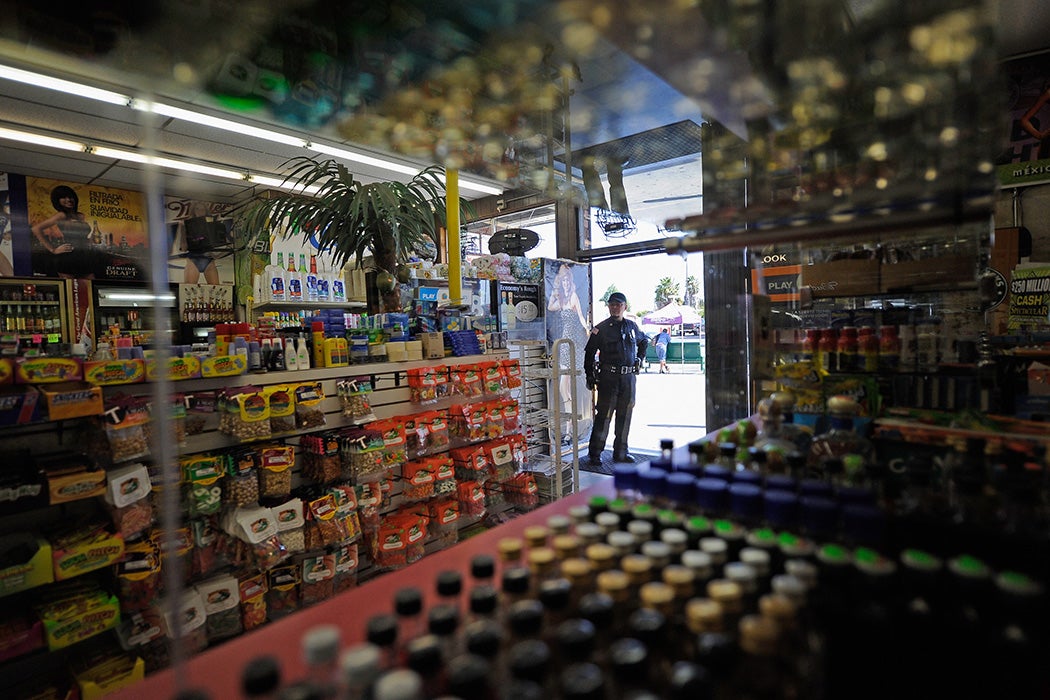By now an icon in the American city, “the Korean-owned store in poor [B]lack urban neighborhoods” has become synonymous with expectations of interracial conflict. “This mode of representation became common in the 1990s,” notes English professor Caroline H. Yang, who traces the popular image of liquor and convenience stores to events such as the killing of teenager Latasha Harlins in 1991 and the unrest that occurred in Los Angeles the year after.
But this shorthand obscures a larger context that Yang uncovers through the 2003 novel Southland by Nina Revoyr, which follows the story of a store in South Los Angeles as it changes hands from the 1940s to 1994.
In the novel, law student Jackie Ishida learns about her late grandfather Frank Sakai’s store, which was destroyed in the violence that swept through the city after three Los Angeles Police Department officers, who stood accused of using excessive force on Black civilian Rodney King, were acquitted at trial in April 1992. She discovers that Frank had meant to leave the store to someone named Curtis Martindale, but Curtis died under mysterious circumstances in the store during the Watts uprising in 1965.
“Employing the genre of mystery and the narrative device of a naïve progeny who does not know her past, the novel takes on the task of excavating the forgotten history of the store,” Yang writes. She highlights how Southland focuses not on the store’s latest proprietors, who are Korean, but on its earlier owner, the Japanese American future-grandfather, Frank. The novel also reveals that Frank, who grew up in that area, originally received the store from an older African American owner for whom he worked.
“By thus setting up the store as a gift, Southland emphasizes that the story of Frank’s store is not an Asian American immigrant history but rather the history of an interracial neighborhood and its coalitional past,” observes Yang.
However, even though Asian merchants and Black residents share the same neighborhoods, Yang writes that “this intersection does not mean that the histories of each group are commensurable”—and the common metaphor of war drives such incommensurability home. The store in Southland is, after all, also the site where four Black youths are killed by the police—including Curtis, who is actually Frank’s unacknowledged son, which prompts Frank to move away.
“Curtis’s death in the Watts rebellion of 1965 seals the store as a site structured by wars of the racist empire-state that cannot be reclaimed through a feel-good narrative of black-Japanese solidarity or interracial romance,” Yang explains, adding that the store becomes present as a setting that “signals the end-point of a particular brand of Afro-Asian unity.”
Weekly Newsletter
Yang’s analysis calls attention to the social, political, and economic forces that govern Asian-owned businesses located in spaces that are “racialized in popular parlance as the ‘ghetto.’” She rejects both “the dominant definition of war zones that criminalizes mostly black and brown residents” and “the myopic claim of economic warfare that views Korean immigrants as agents of exploitation.”
“Rather than assume that the Asian-owned store is an inevitable site of conflict, we might think about how it is used to justify equating urban neighborhoods to war zones as a foregone conclusion,” she writes.
“Doing this requires that we think about how space is racialized and broaden our scope to see the workings of the United States as an empire-state.”
Teaching Tips
- William L. Solomon and William S. Solomon, “Images of Rebellion: News Coverage of Rodney King” (2004)
- Diane C. Fujino, “Race, Place, Space, and Political Development: Japanese-American Radicalism in the ‘Pre-Movement’ 1960s” (2008)
- Monica Chiu, “The Conspicuous Subjects of Interracial Spaces in Nina Revoyrʹs Southland,” in Scrutinized!: Surveillance in Asian North American Literature (2014)
- National Geographic, LA 92 (2017)
- Srimayee Basu, “Reading Los Angeles’ Urban Uprisings: From Watts to Rodney King” (2019)
- Gregory Toy, “Relocating Manzanar: Environmental Histories of Racial Violence in Jeanne Wakatsuki Houston’s Farewell to Manzanar and Nina Revoyr’s Southland” (2020)
- Daniel Widener, “The Afro-Asian City: African American and Japanese American Los Angeles,” in Third Worlds Within: Multiethnic Movements and Transnational Solidarity (2024)
Support JSTOR Daily! Join our membership program on Patreon today.







